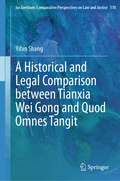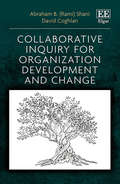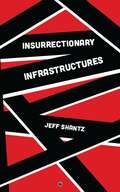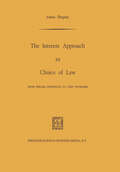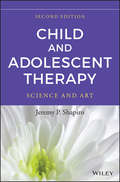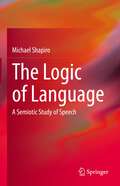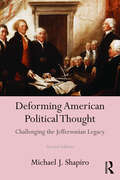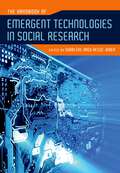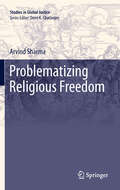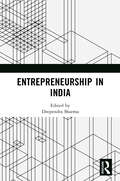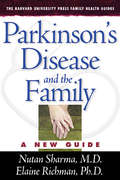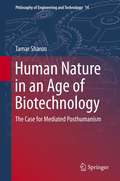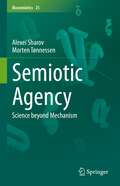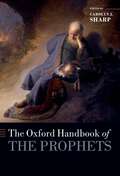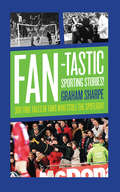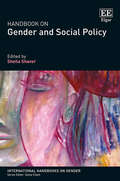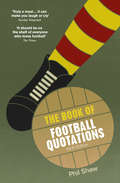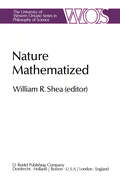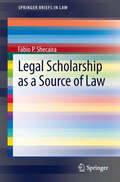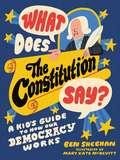- Table View
- List View
A Historical and Legal Comparison between Tianxia Wei Gong and Quod Omnes Tangit (Ius Gentium: Comparative Perspectives on Law and Justice #110)
by Yifan ShangThis book explores the historical and legal importance of two principles, Quod Omnes Tangit, and Tianxia Wei Gong, which have played significant roles in European and Chinese political and legal history. While Quod Omnes Tangit has been thoroughly researched, Tianxia Wei Gong has not been systematically examined. This thesis fills this void and connects these two principles for the first time. Quod Omnes Tangit was initially introduced in Justinian's Codex Civil, while Tianxia Wei Gong originated from Liji, one of the books in a key series of works by Confucius. Liji is comparable to the Thora in the Old Testament and is considered as important as law in Chinese legal history. Both principles have undergone comparable developmental processes, with scholars contributing to their reinterpretation. This book thoroughly examines the interpretations of individual scholars, with particular attention given to Liang Qichao, who is the only one to have mentioned both Tianxia Wei Gong and Quod Omnes Tangit. The book also provides an explanation for the original discrepancies in their concepts, particularly their methodologies in distributing and legitimizing rights. This research will be of interest to legal philosophers and historians in both the Western and Eastern worlds, legal practitioners and policymakers, and researchers seeking to explain current events and explore fundamental differences between the East and West.
Collaborative Inquiry for Organization Development and Change
by Abraham B. Shani David CoghlanThis practical book explores collaborative inquiry as an approach to research and change in organizations where internal members and external researchers work together as partners to address organizational issues and create knowledge about changing organizations. Taking a research-based approach, Abraham B. (Rami) Shani and David Coghlan analyze the challenges that participants face in building a partnership between researchers and practitioners throughout the phases of collaboration. Chapters explore how collaborative partners assess the organization’s current and future capabilities by expressing the present and future in creative imagery and by making relevant changes in the organization to create that future. The book examines the theoretical foundations behind collaborative inquiry in addition to the methodologies of this approach to organization development and change. Mapping both the theory and practice of collaborative inquiry, this book will be a valuable resource for scholars and students of organization studies and research methods, particularly those with a focus on business and management. It will also be beneficial for practitioners interested in collaborative and action research modes.
Insurrectionary Infrastructures
by Jeff ShantzOpponents of states and capital must be prepared to defend ourselves. To understand the nature of the state is to know that it will attack to kill when and where it feels a threat to its authority and power. But the struggles against exploitation, oppression, and repression must also move to the offensive. With the emboldening of reactionary forces on the far Right, there has been a renewed focus on issues of community self-defense, not only against the violence of the state but against organized fascists and Right-wing vigilantes alike. There has also been a developing seriousness, particularly among anarchist and antifascist, or antifa, activists. The goal of all anarchism is not to eliminate violence in social struggle (a futile and impossible pursuit given the nature of the state), but to limit the amount, degree, and extent of violence and harm inflicted by state agents, and their vigilante supporters, on the poor, oppressed, and exploited. And this is part of the emphasis on insurrectionary infrastructures. Non-material (emotional) and material resources and spaces are necessary to defend communities and workplaces under attack, but also to organize possible, and necessary, offensives. Insurrectionary Infrastructures reflects on strategies and tactics of rebellion and resistance and offers suggestions for fighting to win
The Interest Approach to Choice of Law: With Special Reference to Tort Problems
by Amos ShapiraThis book is based on a doctoral thesis submitted to Yale University Law School in 1968. I wish to acknowledge my deepest gratitude to my super visor in the writing of the thesis, Professor Ronald M. Dworkin, whose in sights and criticism have conspicuously contributed to the present work. Time and again I have been inspired by the ideas expressed by hirn both in personal discussions and in his Conflict of Laws and Jurisprudence courses. It has been my privilege also to have had Professors Leon S. Lipson and Guido Calabresi as supervisors. I have derived great benefit from their sug gestions. A sincerely feIt appreciation is expressed to all three persons. A special debt of gratitude is owing to the Yale Law School for the gener ous financial support extended to me. I also wish to record my indebtedness to the Hebrew University of Jerusalem and to Tel-Aviv University for their financial assistance. I am extremely grateful to Mr. Michael Reiss, '68 Yale Law School for his significant editorial assistance. Thanks are also due to my wife Ettie for invaluable help and encouragement. Finally, I wish to thank the publishers for their courtesy and cooperation. A.S.
Child and Adolescent Therapy: Science and Art
by Jeremy P. ShapiroComprehensive introduction to the theory and practice of therapy Child and Adolescent Therapy: Science and Art, Second Edition relies on both psychotherapy research and clinical expertise to create a comprehensive guide to evidence-based practice for providers of child and adolescent therapy. It includes explanations of all major theoretical orientations and the techniques associated with each, with application to the major diagnostic categories. This updated Second Edition includes a new chapter on Mindfulness-Based Cognitive-Behavioral Therapies (Dialectical Behavior Therapy and Acceptance and Commitment Therapy), incorporation of recent neuroscience research, instruction in Motivational Interviewing, and guidance in using therapeutic diagrams with young clients. The book models the thought process of expert therapists by describing how the science and art of therapy can be combined to provide a strong basis for treatment planning and clinical decision-making. Theoretical concepts, empirically supported treatments, and best practices are translated into concrete, detailed form, with numerous examples of therapist verbalizations and conversations between counselor and client. Child and Adolescent Therapy: Science and Art, Second Edition: Explains the work of therapists from the ground up, beginning with fundamentals and moving on to advanced theory and technique Covers the major theoretical approaches: behavioral, cognitive, mindfulness-based, psychodynamic, constructivist, and family systems Guides therapists in planning effective treatment strategies with balanced consideration of outcome research, cultural factors, and individual client characteristics Connects treatment planning with the diagnostic characteristics of the major child and adolescent disorders For both students and skilled clinicians looking for new ideas and techniques, Child and Adolescent Therapy: Science and Art, Second Edition offers a thorough, holistic examination of how best to serve young therapy clients.
Child and Adolescent Therapy: Science and Art
by Jeremy P. ShapiroComprehensive introduction to the theory and practice of therapy Child and Adolescent Therapy: Science and Art, Second Edition relies on both psychotherapy research and clinical expertise to create a comprehensive guide to evidence-based practice for providers of child and adolescent therapy. It includes explanations of all major theoretical orientations and the techniques associated with each, with application to the major diagnostic categories. This updated Second Edition includes a new chapter on Mindfulness-Based Cognitive-Behavioral Therapies (Dialectical Behavior Therapy and Acceptance and Commitment Therapy), incorporation of recent neuroscience research, instruction in Motivational Interviewing, and guidance in using therapeutic diagrams with young clients. The book models the thought process of expert therapists by describing how the science and art of therapy can be combined to provide a strong basis for treatment planning and clinical decision-making. Theoretical concepts, empirically supported treatments, and best practices are translated into concrete, detailed form, with numerous examples of therapist verbalizations and conversations between counselor and client. Child and Adolescent Therapy: Science and Art, Second Edition: Explains the work of therapists from the ground up, beginning with fundamentals and moving on to advanced theory and technique Covers the major theoretical approaches: behavioral, cognitive, mindfulness-based, psychodynamic, constructivist, and family systems Guides therapists in planning effective treatment strategies with balanced consideration of outcome research, cultural factors, and individual client characteristics Connects treatment planning with the diagnostic characteristics of the major child and adolescent disorders For both students and skilled clinicians looking for new ideas and techniques, Child and Adolescent Therapy: Science and Art, Second Edition offers a thorough, holistic examination of how best to serve young therapy clients.
The Logic of Language: A Semiotic Study of Speech
by Michael ShapiroThis book serves as a basis for the exploration of language in a more systematic way. By surveying the several major divisions of language (phonology, morphology, syntax, lexis, tropology) and explicating the way in which sound and meaning cohere in them, this text lays bare––for students, scholars and advanced readers alike––the lineaments of an understanding of what makes language the sign system par excellence, in the service of its most important function as the instrument of cognition and of communication. This book is intended as a companion volume to Shapiro’s The Speaking Self: Language Lore and English Usage. The two volumes taken in tandem will provide a solid grounding in the observational science of linguistics, linking theory with practice in a way that will expand one’s understanding of language as a global phenomenon.
Deforming American Political Thought: Challenging the Jeffersonian Legacy
by Michael J. ShapiroDeforming American Political Thought offers an alternative to the dominant American historical imagination, treating issues that range from the nature of Thomas Jefferson's vision of an egalitarian nation to the persistence of racial inequality. Presenting multifaceted arguments that transcend the myopic scope of traditional political discourses, Michael J. Shapiro summons disparate disciplines and genres – architecture, crime stories, novels, films, and jazz/blues music (among others) to provide approaches to the comprehension of diverse facets of American political thought from the founding to the present. The book’s various investigations disclose that there have always been dissenting voices, articulated in diverse genres of expression that cast doubt on the moral purpose and exceptionalism of the American mind. This highly anticipated updated second edition features a preface focusing on aesthetic theory and the contributions of artistic genres for political analysis, and a completely new chapter on critical thinking about the US western and urban encounters afforded by the two HBO series, Deadwood and The Wire respectively.
Deforming American Political Thought: Challenging the Jeffersonian Legacy
by Michael J. ShapiroDeforming American Political Thought offers an alternative to the dominant American historical imagination, treating issues that range from the nature of Thomas Jefferson's vision of an egalitarian nation to the persistence of racial inequality. Presenting multifaceted arguments that transcend the myopic scope of traditional political discourses, Michael J. Shapiro summons disparate disciplines and genres – architecture, crime stories, novels, films, and jazz/blues music (among others) to provide approaches to the comprehension of diverse facets of American political thought from the founding to the present. The book’s various investigations disclose that there have always been dissenting voices, articulated in diverse genres of expression that cast doubt on the moral purpose and exceptionalism of the American mind. This highly anticipated updated second edition features a preface focusing on aesthetic theory and the contributions of artistic genres for political analysis, and a completely new chapter on critical thinking about the US western and urban encounters afforded by the two HBO series, Deadwood and The Wire respectively.
The Handbook of Emergent Technologies in Social Research
by Sharlene Nagy Hesse-BiberEmergent technologies are pushing the boundaries of how both qualitative and quantitative researchers practice their craft, and it has become clear these changes are dramatically altering research design, from the questions researchers ask and the ways they collect data, to what they even consider data. Gathering a broad range of new developments in one place, The Handbook of Emergent Technologies in Social Research offers comprehensive, up-to-date thinking on technological innovations. In addition to addressing how to effectively apply new technologies-such as the internet, mobile technologies, geospatial technologies (GPS), and the incorporation of computer-assisted software programs (CAQDAS) to qualitative, quantitative, and mixed-methods approaches to research projects-many chapters provide in-depth examples of practices within both disciplinary and interdisciplinary environments and outside the academic world in multi-media laboratories and research institutes. Not only an authoritative view of cutting-edge technologies and their applications, the Handbook examines the costs and benefits of utilizing new technologies on the research process, the potential misuse of these techniques for methods practices, and the ethical and moral dimensions of emergent technologies, especially with regard to issues of surveillance and privacy. The Handbook of Emergent Technologies in Social Research is an essential resource for research methods courses in various fields, including the social sciences, education, communications, computer science, and health services, and an indispensable guide for social researchers looking to incorporate emerging technologies into their methods and practice.
Problematizing Religious Freedom (Studies in Global Justice #9)
by Arvind SharmaThe concept of religious freedom is the favoured modern human rights concept, with which the modern world hopes to tackle the phenomenon of religious pluralism, as our modern existence in an electronically shrinking globe comes to be increasingly characterised by this phenomenon. To begin with, the concept of religious freedom, as embodied in Article 18 of the Universal Declaration of Human Rights, seems self-evident in nature. It is the claim of this book, however, that although emblematic on the one hand, the concept is also problematic on the other, and the implications of the concept of religious freedom are far from self-evident, despite the ready acceptance the term receives as embodying a worthwhile goal. This book therefore problematizes the concept along legal, constitutional, ethical and theological lines, and especially from the perspective of religious studies, so that religious freedom in the world could be enlarged in a way which promotes human flourishing.
Entrepreneurship in India
by Deependra SharmaThis book introduces readers and students to the entrepreneurial process. It is important as evidence has suggested that the probability of entrepreneurs’ success enhances when they thoroughly appreciate the components of the entrepreneurial process as well as how to effectively use them. The fact that nearly 33 percent of new firms fail within the first two years while twenty percent fail within four to five years of their existence makes it evident that while many people are highly motivated to start new firms, motivation alone is not sufficient, rather it should be coupled with relevant information, a strong business idea, a well-crafted business plan, and sound execution to maximize chances for success. This work offers an insightful and a practical guide to the process of launching and growing an entrepreneurial organisation with success. It will therefore serve as an important resource to students of Entreprenuership and to anyone interested in the field, academically or practically.
Entrepreneurship in India
by Deependra SharmaThis book introduces readers and students to the entrepreneurial process. It is important as evidence has suggested that the probability of entrepreneurs’ success enhances when they thoroughly appreciate the components of the entrepreneurial process as well as how to effectively use them. The fact that nearly 33 percent of new firms fail within the first two years while twenty percent fail within four to five years of their existence makes it evident that while many people are highly motivated to start new firms, motivation alone is not sufficient, rather it should be coupled with relevant information, a strong business idea, a well-crafted business plan, and sound execution to maximize chances for success. This work offers an insightful and a practical guide to the process of launching and growing an entrepreneurial organisation with success. It will therefore serve as an important resource to students of Entreprenuership and to anyone interested in the field, academically or practically.
Parkinson's Disease and the Family (The Harvard University Press Family Health Guides)
by Nutan Sharma Elaine RichmanToo often, with Parkinson's disease, a loved one serves as medical interpreter, patient advocate, and caregiver. Sharma and Richman draw on the latest research and clinical practice techniques to offer valuable suggestions for managing patient care and, perhaps more important, for healing the family unit.
Outbound Hiring
by Vijay Sharma Kaushik Satish Aadil BandukwalaOutbound focuses time and effort on candidates who are most relevant and more likely to convert. It's a “100% Results-Focused” strategy that fills your hiring funnel with people that your recruiters and hiring leaders believe are right for the role - thereby dramatically increasing focus, saving time and boosting your efficiency.
Human Nature in an Age of Biotechnology: The Case for Mediated Posthumanism (Philosophy of Engineering and Technology #14)
by Tamar SharonNew biotechnologies have propelled the question of what it means to be human – or posthuman – to the forefront of societal and scientific consideration. This volume provides an accessible, critical overview of the main approaches in the debate on posthumanism, and argues that they do not adequately address the question of what it means to be human in an age of biotechnology. Not because they belong to rival political camps, but because they are grounded in a humanist ontology that presupposes a radical separation between human subjects and technological objects.The volume offers a comprehensive mapping of posthumanist discourse divided into four broad approaches—two humanist-based approaches: dystopic and liberal posthumanism, and two non-humanist approaches: radical and methodological posthumanism. The author compares and contrasts these models via an exploration of key issues, from human enhancement, to eugenics, to new configurations of biopower, questioning what role technology plays in defining the boundaries of the human, the subject and nature for each. Building on the contributions and limitations of radical and methodological posthumanism, the author develops a novel perspective, mediated posthumanism, that brings together insights in the philosophy of technology, the sociology of biomedicine, and Michel Foucault’s work on ethical subject constitution. In this framework, technology is neither a neutral tool nor a force that alienates humanity from itself, but something that is always already part of the experience of being human, and subjectivity is viewed as an emergent property that is constantly being shaped and transformed by its engagements with biotechnologies. Mediated posthumanism becomes a tool for identifying novel ethical modes of human experience that are richer and more multifaceted than current posthumanist perspectives allow for.The book will be essential reading for students and scholars working on ethics and technology, philosophy of technology, poststructuralism, technology and the body, and medical ethics.
Semiotic Agency: Science beyond Mechanism (Biosemiotics #25)
by Alexei Sharov Morten TønnessenThis book invites readers to embark on a journey into the world of agency encompassing humans, other organisms, cells, intracellular molecular agents, colonies, populations, ecological systems, and artificial autonomous systems. We combine mechanistic and non-mechanistic approaches in the analysis of the function and evolution of organisms, their subagents, and multi-organism systems, and in this way offer a theoretical platform for integrating biosemiotics with both natural science and the humanities/social sciences. Agents are autonomous systems that incorporate knowledge on how to make sense of their environment and use it to achieve their goals. The functions of all agents are supported by mechanisms at the lowest level; however, the explanatory power of mechanistic analysis is not sufficient for complex agents. Non-mechanistic methods rely on the goal-directedness of agents whose dynamics follow self-stabilized dynamic attractors. The properties of attractors depend on stable or slowly changing factors, and such dependencies can be interpreted as sign relations if they are adaptive in nature. Agents can replace or redirect mechanisms on demand in order to preserve their functions; for performing higher-level semiotic functions, mechanisms are thus only means. We assume that mechanism and semiosis are not mutually exclusive, and that simple agents can interpret signs mechanistically. This assumption allows us to extend semiotic analysis to all agents, including ribosomes in cells, computers, and robots. This book challenges established traditions in natural science and the humanities/social sciences: semiotics no longer appears as restricted to humans and rational thinking, and biology is no longer limited to rely exclusively on mechanistic reasoning.
The Oxford Handbook of the Prophets (Oxford Handbooks)
by Carolyn J. SharpThe Latter Prophets--Isaiah, Jeremiah, Ezekiel, and the Book of the Twelve--comprise a fascinating collection of prophetic oracles, narratives, and vision reports from ancient Israel and Judah. Spanning centuries and showing evidence of compositional growth and editorial elaboration over time, these prophetic books offer an unparalleled view into the cultural norms, theological convictions, and political disputes of Israelite communities caught in the maelstrom of militarized conflicts with the empires of ancient Egypt, Babylonia, and Persia. Instructive for scholar and student alike, The Oxford Handbook of the Prophets features wide-ranging discussion of ancient Near Eastern social and cultic contexts; exploration of focused topics such as the persona of the prophet and the problem of violence in prophetic rhetoric; sophisticated historical and literary analysis of key prophetic texts; issues in reception history, from these texts' earliest reinterpretations at Qumran to Christian appropriations in contemporary homiletics; feminist, materialist, and postcolonial readings engaging the insights of influential contemporary theorists; and more. The diversity of interpretive approaches, clarity of presentation, and breadth of expertise represented here will make this Handbook indispensable for research and teaching on the Latter Prophets.
The Oxford Handbook of the Prophets (Oxford Handbooks)
by Carolyn J. SharpThe Latter Prophets--Isaiah, Jeremiah, Ezekiel, and the Book of the Twelve--comprise a fascinating collection of prophetic oracles, narratives, and vision reports from ancient Israel and Judah. Spanning centuries and showing evidence of compositional growth and editorial elaboration over time, these prophetic books offer an unparalleled view into the cultural norms, theological convictions, and political disputes of Israelite communities caught in the maelstrom of militarized conflicts with the empires of ancient Egypt, Babylonia, and Persia. Instructive for scholar and student alike, The Oxford Handbook of the Prophets features wide-ranging discussion of ancient Near Eastern social and cultic contexts; exploration of focused topics such as the persona of the prophet and the problem of violence in prophetic rhetoric; sophisticated historical and literary analysis of key prophetic texts; issues in reception history, from these texts' earliest reinterpretations at Qumran to Christian appropriations in contemporary homiletics; feminist, materialist, and postcolonial readings engaging the insights of influential contemporary theorists; and more. The diversity of interpretive approaches, clarity of presentation, and breadth of expertise represented here will make this Handbook indispensable for research and teaching on the Latter Prophets.
Fan-tastic Sporting Stories: 300 True Tales of Fans Who Stole the Limelight
by Graham SharpeFor some fans, a ringside seat just isn't close enough to the action. Stretching from the benign to the malign, from the entertaining to the insane, and from the sublime to the ridiculous, this compelling compendium contains over 300 true tales of fanatical fans who stole the spotlight from their sporting heroes. This is the good, the bad and the ugly side of spectator intervention - from streakers to rioters, and beyond. We've all felt the thrill of cheering on our sporting heroes, but there's a fine line between the mere fan and the true fanatic and this absorbing new book from Graham Sharpe well and truly crosses it. With its weird and wild tales of fan participation, Fan-tastic Sporting Stories! is essential reading for fans of any and every sport. Whatever your team, whatever your game, you won't help but find this collection absolutely fan-tastic!
Handbook on Gender and Social Policy (International Handbooks on Gender series)
by Sheila ShaverAfter two decades of feminist challenges to mainstream theorising, gender has become a central element of social policy and the welfare state. A new literature has widened the focus of social policy from state and economy to a three-sided discourse encompassing the state, the market and the family. The Handbook on Gender and Social Policy provides a comprehensive introduction to this field with up-to-date accounts of debates and innovative original research by leading international authors. The Handbook covers the key areas of social policy that relate to the inequalities between men and women in the developed and developing world. It presents original research on contemporary issues at national and transnational levels across the central policy terrain of income, employment, care and family policy, including family policy models, same-sex marriage and child protection. It features chapters on key perspectives on gender and policy and six original studies of the state of play in different regions of the world. The Handbook on Gender and Social Policy is an excellent resource for advanced students and postgraduate students of sociology, political science, women’s studies, policy studies and related areas. It will also be of interest for practitioners and scholars of social policy seeking up-to-date coverage of how gender affects the contours of social policy and politics.
The Book of Football Quotations
by Phil ShawThe greatest football quotations collection ever, now in its ninth edition.This compilation includes quotes from everyone – Shakespeare to Suarez, Camus to Cantona, Busby to Beckham – who has made an apt, pithy or comical comment about football. And not just footballers and managers either – fans, pundits, groundsmen, directors and wives all get to have their say too. Every subject is covered, from tactical debates to changing lifestyles, to produce a sometimes hilarious and always thought-provoking commentary on the game.‘My players are always the best players in the world, even if they aren’t’ - José Mourinho‘He was a quiet man, Eric Cantona, but he was a man of few words’ - David Beckham‘Sometimes when you aim for the stars you hit the moon’ - Ian Holloway
Nature Mathematized: Historical and Philosophical Case Studies in Classical Modern Natural Philosophy (The Western Ontario Series in Philosophy of Science #20)
by William R. SheaThese remarks preface two volumes consisting of the proceedings of the Third International Conference on the History and Philosophy of Science of the International Union of History and Philosophy of Science. The conference was held under the auspices of the Union, The Social Sciences and Humanities Research Council of Canada, and the Canadian Society for History and Philosophy of Science. The meetings took place in Montreal, Canada, 25--29 August 1980, with Concordia University as host institution. The program of the conference was arranged by a Joint Commission of the International Union of History and Philosophy of Science consisting of Robert E. Butts (Canada), John Murdoch (U. S. A. ), Vladimir Kirsanov (U. S. S. R. ), and Paul Weingartner (Austria). The Local Arrangements Committee consisted of Stanley G. French, Chair (Concordia), Michel Paradis, treasurer (McGill), Franyois Duchesneau (Universite de Montreal), Robert Nadeau (Universite du Quebec a Montreal), and William Shea (McGill University). Both committees are indebted to Dr. G. R. Paterson, then President of the Canadian Society for History and Philosophy of Science, who shared his expertise in many ways. Dr. French and his staff worked diligently and efficiently on behalf of all participants. The city of Montreal was, as always, the subtle mixture of extravagance, charm, warmth and excitement that retains her status as the jewel of Canadian cities. The funding of major international conferences is always a problem.
Legal Scholarship as a Source of Law (SpringerBriefs in Law)
by Fábio P. ShecairaThis book is about the use of legal scholarship by judges. It discusses the possibility that legal scholarship may function as a genuine source of law in modern municipal legal systems. The book advances a number of claims, some conceptual, some empirical, some normative. The major conceptual claims are found in Chapters 2 and 3, where a general account of the notion of a source of law is provided. Roughly, sources of law are documents or practices (e.g. statutes, judicial decisions, official customs) from which norms can be derived that function as sources of content-independent reasons for judges to decide legal cases one way or another. The relevant notion of content-independence is derived (with qualifications) from H.L.A. Hart’s jurisprudence. Indeed, the book’s analysis of the concept of a source of law relies at various points on Hartian insights about law and legal reasoning. Chapter 4 argues that legal scholarship – or, more precisely, a particular type of legal scholarship that might be described as standard or doctrinal – can be, and indeed is, used as a source of law in modern legal systems. The conclusion that legal scholarship is used as a source of law (and thus as a source of content-independent reasons for action) may come as a surprise to those who associate judicial recourse to legal scholarship with judicial activism. This association is discussed and criticized in Chapters 5 and 6. It is argued that, in spite of a relatively common opinion to the contrary, legal scholarship can be used to mitigate discretion. In fact, it is precisely because it can be used in this way that judges sometimes refer to scholarship deceptively and suggest that it limits discretion in situations in which it really does not. The concluding chapter addresses potential objections not explicitly discussed in earlier chapters.
What Does the Constitution Say?: A Kid's Guide to How Our Democracy Works
by Ben SheehanIf you've never read the Constitution, let this guidebook help you! Featuring fun facts, cool illustrations, and even hilarious jokes, What Does the Constitution Say? will help you understand how our American government really works. Written more than 230 years ago, the Constitution can be hard to understand (even for adults). But it also gives you what you need to make our country the best it can be for everyone. What Does the Constitution Say? takes you on a tour of the whole Constitution while explaining what its fancy words really mean. From the Preamble to the 7 Articles to the 27 Amendments (so far), this fun-to-read guide is packed with bite-sized info, historic quotes, and graphics on important topics such as:Why the Constitution is a "living document"How the first attempt at a constitution (the Articles of Confederation) failedWhat powers the president does (and doesn't) haveKey figures like James Madison, Alexander Hamilton, and George WashingtonA bonus section on the Declaration of IndependenceAnd much more!
